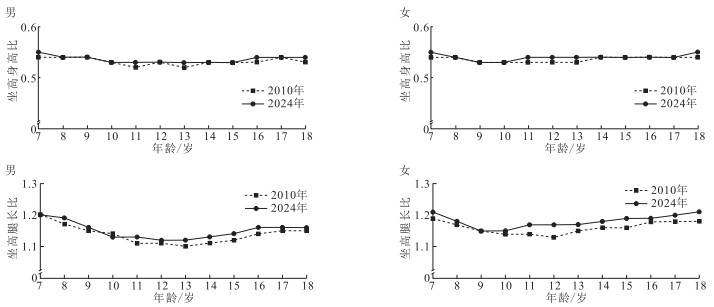Changes in the body shape and ergonomic compatibility for functional dimensions of desks and chairs for students in Harbin during 2010-2024
-
摘要:
目的 分析哈尔滨市2010—2024年学生身体形态指标与比例的变化趋势,探讨学校课桌椅功能尺寸与当前学生形态指标的适配性,为课桌椅标准修订提供参考依据。 方法 分别于2010及2024年的9—11月,采用方便抽样与分层整群抽样相结合的方法,在哈尔滨市抽取3个区的学生共6 590和6 252名,测量并比较15年间学生的身高、坐高、小腿长、大腿长等形态指标与比例变化,并将2024年数据与现行学校课桌椅标准功能尺寸进行比较。采用t检验、Mann-Whitney U检验进行统计分析。 结果 2010—2024年,男、女生身高平均增量分别为1.8和1.5 cm,坐高增量均为1.5 cm,小腿长增量为0.3和0.4 cm,大腿长增量均为0.5 cm;坐高/身高、坐高/腿长的平均增量均小于0.1。桌椅高差与1/3坐高的差值在0.4~0.8 cm,适配0号课桌椅的学生中有22.0%桌椅高差与1/3坐高差值小于0,身高较高学生使用课桌椅时,桌椅高差可能存在不足;座面高与腓骨点高的差值在-1.4~1.1 cm,座面深与腘臀长的差值在-9.8~-3.4 cm;肥胖学生中,座面宽与1/2臀围的差值在-20.5~-8.7 cm,非肥胖学生的差值在-12.2~-3.8 cm。 结论 现行课桌椅标准基本满足卫生学要求,但对超高及肥胖学生需要通过调整课桌椅分配或进行个性化调整以满足卫生学要求。 Abstract:Objective To analyze the change trends in the body shape indicators and proportions of students in Harbin from 2010 to 2024, and to investigate ergonomic compatibility of functional dimensions of school desks and chairs with current student shape indicators, so as to provide a reference for revising furniture standards of desks and chairs. Methods Between September and November of both 2010 and 2024, a combination of convenience sampling and stratified cluster random sampling was conducted across three districts in Harbin, yielding samples of 6 590 and 6 252 students, respectively. Anthropometric shape indicators cluding height, sitting height, crus length, and thigh length-and their proportional changes were compared over the 15-year period. The 2024 data were compared with current standard functional dimensions of school furniture. The statistical analysis incorporated t-test and Mann-Whitney U test. Results From 2010 to 2024, average height increased by 1.8 cm for boys and 1.5 cm for girls; sitting height increased by 1.5 cm for both genders; crus length increased by 0.3 cm for boys and 0.4 cm for girls; and thigh length increased by 0.5 cm for both genders. The ratios of sitting height to height, and sitting height to leg length increased by less than 0.1. The difference between desk-chair height and 1/3 sitting height ranged from 0.4-0.8 cm. Among students matched with size 0 desks and chairs, 22.0% had a desk-to-chair height difference less than 0, indicating that the desk-to-chair height difference might be insufficient for taller students. The differences between seat height and fibular height ranged from -1.4 to 1.1 cm; and the differences between seat depth and buttock-popliteal length ranged from -9.8 to 3.4 cm. Among obese students, the differences between seat width and 1/2 hip circumference ranged from -20.5 to -8.7 cm, while it ranged from -12.2 to -3.8 cm among non-obese students. Conclusion Current furniture standards basically satisfy hygienic requirements; however, in the case of exceptionally tall and obese students, ergonomic accommodations such as adaptive seating allocation or personalized adjustments are recommended to meet hygienic requirements. -
Key words:
- Desk and chair /
- Physical examination /
- Adaptation, biological /
- Students
1) 利益冲突声明 所有作者声明无利益冲突。 -
表 1 哈尔滨市不同性别各年龄组学生2010与2024年身体形态指标比较(x±s, cm)
Table 1. Comparison of anthropometric measurements among students of different genders and age groups in Harbin City between 2010 and 2024(x±s, cm)
性别 年龄/岁 身高 坐高 2010年 2024年 差值 t值 2010年 2024年 差值 t值 男 6 122.9±5.4 68.1±3.1 7 129.0±5.8 129.4±5.9 0.4 0.96 70.2±3.1 70.6±3.2 0.4 1.37 8 134.1±5.6 134.4±6.5 0.3 0.61 72.1±3.1 72.9±3.3 0.8 2.59* 9 139.5±6.0 141.1±6.9 1.6 2.92** 74.6±3.0 75.6±3.6 1.0 3.33** 10 144.2±6.6 146.9±7.6 2.7 4.48** 76.7±3.5 77.9±4.1 1.2 3.88** 11 150.4±7.4 153.3±7.8 2.9 4.51** 78.9±4.0 81.2±4.4 2.3 6.36** 12 158.1±8.0 160.5±8.9 2.4 3.37** 83.1±4.4 84.9±4.7 1.8 4.57** 13 164.5±8.1 166.8±8.3 2.3 3.14** 86.1±4.6 88.1±4.8 2.0 4.64** 14 169.7±6.5 171.9±6.4 2.2 3.96** 89.3±3.8 91.2±3.9 1.9 5.90** 15 171.3±7.1 174.2±6.1 2.9 4.85** 90.3±3.8 92.8±3.6 2.5 7.44** 16 172.7±6.4 175.3±6.4 2.6 5.02** 91.7±3.5 94.2±3.4 2.5 8.77** 17 173.9±6.4 175.4±6.4 1.5 2.52* 93.0±3.2 94.2±3.3 1.2 4.00** 18 174.1±6.0 173.8±6.2 -0.3 -0.42 92.9±3.1 93.4±3.3 0.5 1.31 女 6 121.6±5.6 67.3±3.0 7 127.8±5.4 127.1±5.9 -0.7 -1.43 69.4±2.7 69.5±3.0 0.1 0.40 8 133.1±6.0 133.6±6.6 0.5 0.87 71.6±3.2 72.1±3.4 0.5 1.92 9 138.4±6.0 140.3±7.0 1.9 3.18** 73.9±3.2 75.0±3.9 1.1 3.44** 10 144.0±6.6 147.1±7.1 3.1 5.05** 76.5±3.7 78.5±4.3 2.0 5.63** 11 151.3±7.0 154.7±7.3 3.4 5.45** 80.5±4.1 83.2±4.3 2.7 7.67** 12 156.8±6.2 158.5±6.5 1.7 3.05** 83.3±3.6 85.5±3.8 2.2 6.71** 13 160.1±5.8 161.1±5.4 1.0 2.09* 85.4±3.1 86.9±3.0 1.5 5.29** 14 160.6±5.1 162.2±5.6 1.6 3.36** 86.1±2.9 87.7±3.1 1.6 6.21** 15 160.8±5.8 162.4±5.3 1.6 3.41** 86.1±2.9 88.3±2.9 2.2 9.10** 16 161.0±5.7 162.8±5.7 1.8 3.97** 87.0±2.9 88.5±3.0 1.5 6.12** 17 161.0±5.4 162.6±5.8 1.6 3.02** 87.1±2.7 88.5±3.0 1.4 5.26** 18 161.0±5.3 162.0±4.6 1.0 1.43 87.2±2.6 88.6±2.8 1.4 3.21** 性别 年龄/岁 小腿长 大腿长 2010年 2024年 差值 t值 2010年 2024年 差值 t值 男 6 29.3±1.7 32.3±1.9 7 31.6±1.9 31.3±1.9 -0.3 -2.19* 34.0±2.1 34.3±2.0 0.3 1.81 8 33.2±2.1 32.7±2.0 -0.5 -2.56** 35.4±2.3 36.1±2.0 0.7 3.55** 9 34.7±1.8 35.0±2.2 0.3 2.12** 38.0±2.6 38.0±2.4 <0.1 -0.28 10 36.3±2.1 36.3±2.1 <0.1 0.31 39.4±2.5 39.5±2.3 0.1 0.38 11 37.9±2.1 38.7±2.3 0.8 4.04** 40.8±2.4 41.4±2.7 0.6 2.24* 12 39.3±2.2 40.2±2.4 0.9 4.26** 42.0±2.2 43.3±2.9 1.3 1.86 13 41.1±2.4 41.7±2.3 0.6 2.91** 45.0±2.7 14 42.1±2.0 42.7±2.1 0.6 3.36** 46.6±2.3 15 42.2±2.3 42.6±2.1 0.4 2.02* 46.7±2.8 16 42.3±2.2 42.4±2.1 0.1 0.83 46.7±2.8 17 42.2±2.2 42.5±2.1 0.3 1.56 47.1±2.9 18 42.5±2.2 42.3±2.0 -0.2 -1.01 47.1±2.5 女 6 29.2±1.8 32.3±2.1 7 31.7±1.8 30.8±1.9 -0.9 -5.51** 34.0±2.0 34.0±1.9 <0.1 0.99 8 33.1±1.9 32.7±1.9 -0.4 -2.35* 35.4±2.4 36.0±2.4 0.6 2.08** 9 34.5±1.9 34.9±2.2 0.4 1.96 37.6±2.4 37.8±2.4 0.2 0.83 10 36.1±2.0 36.4±2.0 0.3 1.45 39.3±2.4 39.5±2.5 0.2 1.06 11 37.5±1.9 38.6±2.1 1.1 6.05** 41.1±2.4 41.7±2.7 0.6 2.26* 12 38.5±1.9 39.2±1.9 0.7 3.62** 41.9±1.4 43.2±2.6 1.3 1.48 13 39.0±1.9 39.7±1.7 0.7 3.94** 43.8±2.5 14 39.2±1.9 39.7±1.9 0.5 2.96** 44.1±2.5 15 38.9±2.0 39.4±1.8 0.5 3.31** 44.2±2.5 16 38.6±1.9 39.4±1.8 0.8 5.00** 44.4±2.5 17 38.6±2.1 39.4±1.9 0.8 3.98** 44.4±2.5 18 38.8±1.9 39.2±1.8 0.4 1.45 44.7±2.1 注:*P<0.05,**P<0.01;2010年因调查需要,仅测量了7~12岁学生的大腿长。 表 2 哈尔滨市学生身体形态指标与课桌椅尺寸标准的差值/cm
Table 2. Differences between anthropometric measurements of students in Harbin and standard desk-chair dimensions/cm
课桌椅型号 身高范围 差值1 差值2 差值3 差值4 差值5 0号 ≥180 0.6 1.1 -9.4 -19.5 -11.3 1号 173~187 0.5 0.6 -9.8 -20.5 -12.1 2号 165~179 0.5 0.1 -8.3 -19.0 -11.1 3号 158~172 0.5 -0.3 -6.6 -17.3 -9.8 4号 150~164 0.6 -0.9 -8.8 -18.2 -12.2 5号 143~157 1.0 -1.4 -6.6 -14.3 -9.3 6号 135~149 1.7 -1.2 -4.1 -11.1 -5.5 7号 128~142 1.7 -1.1 -7.2 -12.8 -7.5 8号 120~134 1.8 -0.9 -5.0 -10.4 -5.5 9号 113~127 0.6 -0.3 -3.4 -10.4 -5.2 10号 ≤119 0.4 -0.9 -4.8 -8.7 -3.8 注:课桌椅型号、身高范围、桌面高、座面高、座面深、座面宽来源于《学校课桌椅功能尺寸及技术要求》(GB/T 3976—2014)[6];桌椅高差=桌面高-座面高;差值1为桌椅高差-1/3坐高;差值2为座面高-腓骨点高;差值3为座面深-腘臀长;差值4为座面宽-肥胖学生的1/2臀围;差值5为座面宽-非肥胖学生的1/2臀围。 -
[1] 季成叶, 胡佩瑾, 何忠虎. 中国儿童青少年生长长期趋势及其公共卫生意义[J]. 北京大学学报(医学版), 2007, 39(2): 126-131.JI C Y, HU P J, HE Z H. Secular growth trends in the Chinese urban youth and its implications on public health[J]. J Peking Univ (Health Sci), 2007, 39(2): 126-131. (in Chinese) [2] 高迪, 董彦会, 尹杨, 等. 中国2005-2014年中小学生身高体重变化趋势分析[J]. 中国学校卫生, 2018, 39(2): 252-255, 259.GAO D, DONG Y H, YIN Y, et al. Secular trends of height and weight in Chinese children from 2005 to 2014[J]. Chin J Sch Health, 2018, 39(2): 252-255, 259. (in Chinese) [3] 国家标准局. 学校课桌椅功能尺寸: GB 3976-1983[S]. 北京: 中国标准出版社, 1983.Standardization Administration of China. The functional sizes of desks and chairs for school: GB 3976-1983[S]. Beijing: Standards Press of China, 1983. (in Chinese) [4] 国家标准局. 学校课桌椅卫生标准: GB 7792-1987[S]. 北京: 中国标准出版社, 1987.Standardization Administration of China. Hygienic standard of desks and chairs for school: GB 7792-1987[S]. Beijing: Standards Press of China, 1987. (in Chinese) [5] 中华人民共和国国家质量监督检验检疫总局. 学校课桌椅功能尺寸: GB/T 3976-2002[S]. 北京: 中国标准出版社, 2002.General Administration of Quality Supervision, Inspection and Quarantine of the PRC. Functional sizes of desks and chairs for educational institutions: GB/T 3976-2002[S]. Beijing: Standards Press of China, 2002. (in Chinese) [6] 中华人民共和国国家质量监督检验检疫总局. 学校课桌椅功能尺寸及技术要求: GB/T 3976-2014[S]. 北京: 中国标准出版社, 2014.General Administration of Quality Supervision, Inspection and Quarantine of the PRC. Functional sizes and technical requirements of desks and chairs for educational institutions: GB/T 3976-2014[S]. Beijing: Standards Press of China, 2014. (in Chinese) [7] SAARNI L, NYGÅRD C-H, KAUKIAINEN A, et al. Are the desks and chairs at school appropriate?[J]. Ergonomics, 2007, 50(10): 1561-1570. [8] ARAúJO L G L, RODRIGUES V P, FIGUEIREDO I A, et al. Association between sitting posture on school furniture and spinal changes in adolescents[J]. Int J Adolesc Med Health, 2020, 34: 469-475. [9] ASSIRI A, MAHFOUZ A A, AWADALLA N J, et al. Classroom furniture mismatch and back pain among adolescent school-children in Abha City, Southwestern Saudi Arabia[J]. Int J Adolesc Med Health, 2019, 16(8): 1395. [10] 中国学生体质与健康研究组. 2010年中国学生体质与健康调研报告[M]. 北京: 高等教育出版社, 2012.Research Group of Physical Fitness and Health Research of Chinese School Students. Report on the physical fitness and health surveillance of Chinese school students (2010)[M]. Beijing: Higher Education Press, 2012. (in Chinese) [11] 中国学生体质与健康研究组. 2019年中国学生体质与健康调研报告[M]. 北京: 高等教育出版社, 2022.Research Group of Physical Fitness and Health Research of Chinese School Students. Report on the physical fitness and health surveillance of Chinese school students (2019)[M]. Beijing: Higher Education Press, 2022. (in Chinese) [12] 中华人民共和国国家卫生健康委员会. 学龄儿童青少年超重与肥胖筛查: WS/T 586-2018[S]. 2018-08-01.National Health Commission of the PRC. Screening for overweight and obesity among school-age children and adolescents: WS/T 586-2018[S]. 2018-08-01. (in Chinese) [13] 张亚钦, 李辉, 季成叶. 中国0~18岁正常儿童青少年身体比例生长规律的研究[J]. 中国循证儿科杂志, 2010, 5(5): 349-354.ZHANG Y Q, LI H, JI C Y. Study on body proportions of 0-18 years old children and adolescents in China[J]. Chin J Evid Based Pediatr, 2010, 5(5): 349-354. (in Chinese) [14] 何璐娜, 鞠勃, 尚进, 等. 哈尔滨市中小学生身材比例变化情况[J]. 中国学校卫生, 2012, 33(9): 1105-1107, 1110.HE L N, JU B, SHANG J, et al. Variation tendency of body proportion for primary and middle school students in Harbin[J]. Chin J Sch Health, 2012, 33(9): 1105-1107, 1110. (in Chinese) [15] CHENG J C, LEUNG S S, LAU J. Anthropometric measurements and body proportions among Chinese children[J]. Clin Orthop Relat Res, 1996(323): 22-30. [16] BUNDAK R, BAS F, FURMAN A, et al. Sitting height and sitting height/height ratio references for Turkish children[J]. Eur J Pediatr, 2014, 173(7): 861-869. [17] International Standard. Furniture-chairs and tables for educational institutions-functional sizes: ISO 5970-1979[S]. Switgerland: International Organization for Standardization, 1979. [18] 唐锡麟. 对国家标准《学校课桌椅功能尺寸》的理解[J]. 学校卫生, 1987, 8(3): 15-17.TANG X L. Understanding of national standard for Functional Dimensions of School Desks and Chairs[J]. Chin J Sch Health, 1987, 8(3): 15-17. (in Chinese) [19] 王忆军, 唐锡麟, 岳凤娟, 等. 学校课桌椅高度标准的修订研究[J]. 中国学校卫生, 2000, 21(6): 442-444.WANG Y J, TANG X L, YUE F J, et al. Revision of height standard of chairs and desks for China schools[J]. Chin J Sch Health, 2000, 21(6): 442-444. (in Chinese) [20] BOWES C E. Posture: sitting, standing, chair design and exercise[J]. Physiotherapy, 1989, 75(6): 367. [21] PANERO J, ZELNIK M. Human dimension and interior space: a source book of design reference standards[M]. New York: Watson-Guptill, 1979. [22] 胡霄, 李丽, 欧阳一非, 等. 2000-2018年中国十六省(自治区、直辖市)7~17岁儿童青少年超重与肥胖流行趋势[J]. 卫生研究, 2022, 51(4): 568-573.HU X, LI L, OUYANG Y F, et al. Trends of overweight and obesity among children and adolescents aged 7-17 in 16 provinces of China from 2000 to 2018[J]. J Hyg Res, 2022, 51(4): 568-573. (in Chinese) -







 下载:
下载:

